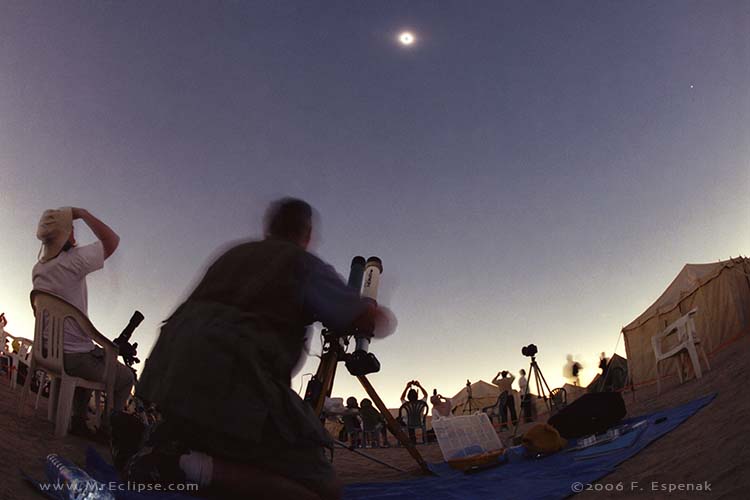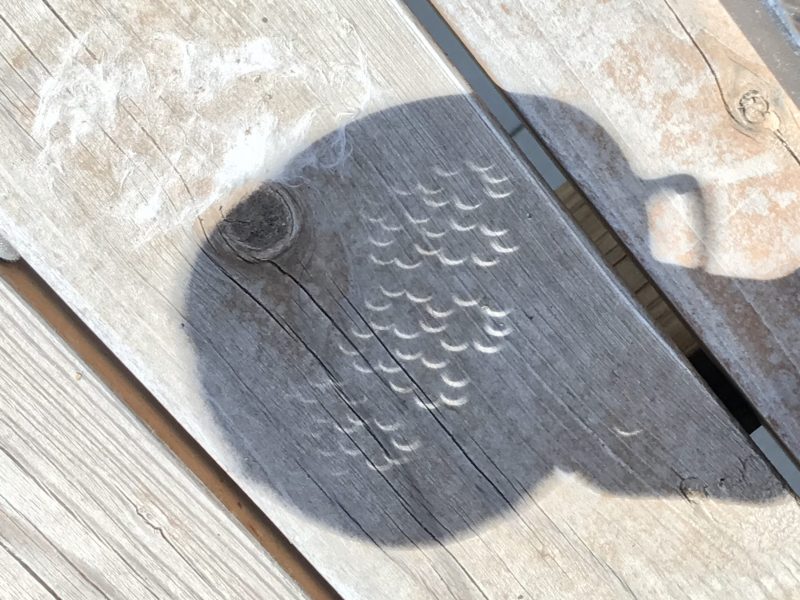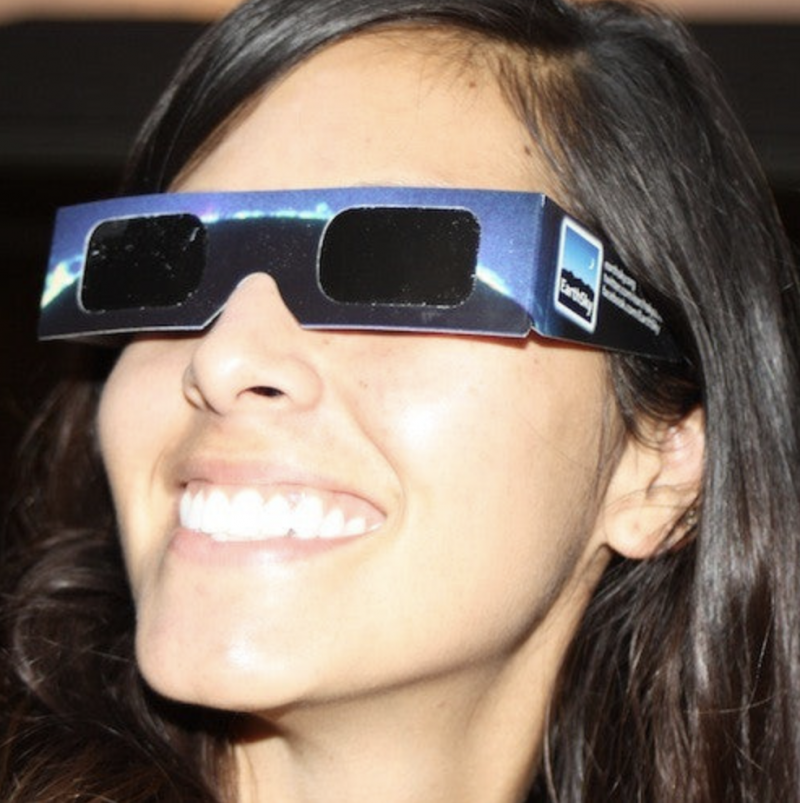
Looking for info on the giant sunspot of January, 2023? Click here.
You learned long ago you should never look at the sun directly. Gazing sunward without eye protection can permanently damage your eyes, even causing blindness. But Solar Cycle 25 is ramping up, and there is going to be an increasing number of spots on the sun in the coming years. Look below for tips on observing the sun safely.
Do NOT use these techniques.
Whatever you do, never look at the sun directly without a safe filter in place to protect your eyes.
Besides your unprotected eyeballs, here are some other things you should not use: Do NOT use sunglasses, polaroid filters, smoked glass, exposed color film, X-ray film, or photographic neutral density filters.
DO use these techniques for observing the sun safely
Safe commercial solar filters for a telescope. If you have a ‘scope, you’ll need a safe solar filter on the sky end of it in order to search for sunspots or watch a solar eclipse safely. Do not use a filter on the eyepiece end of your telescope. There’s too much to say about solar filters to include in this article, so we refer you to Fred Espenak’s article on safe solar filters. If you don’t have a ‘scope, you still have plenty of options, such as …
A home-rigged, indirect viewing method. Creating a pinhole camera is another great option, because it lets your family and friends get a good view of the sun, too. We recommend this article by the masters of do-it-yourself science at the Exploratorium in San Francisco. Their article on how to view solar eclipses safely teaches you to make an easy pinhole projector. With it, you can shine the sun’s image onto a flat surface and impress your friends and neighbors while giving everyone (including yourself) a cool experience.
But don’t go yet. There’s more …

Local viewing at an astronomy club, park or nature center. We highly recommend this route for any kind of eclipse, any daytime solar viewing, or any nighttime astronomical event. If you watch among other amateur astronomers and casual sky gazers, you’ll have fun, learn about astronomy and get a great view of the objects and events going on in the sky. SkyandTelescope.com offers a way to search for astronomy clubs in your area. Or try the NASA Night Sky Network, which is another way to search. Here’s a search page from Go-astronomy.com. And here are astronomy clubs and societies affiliated with the Astronomical League, one of this nation’s most established confederations of amateur astronomers.
Commercial solar eclipse glasses. You might find these online or at a local nature center, or museum. Solar eclipse glasses are super easy to use, and they’re sort of cool-looking.

And there’s still more …
Welder’s glass, #14 or darker. Be sure it is #14 or darker. The great thing about welder’s glass is that it allows you to view the sun directly. Plus, welder’s glass is a bit more durable than commercial eclipse glasses. If you’re like me, between solar eclipses you’ll forget where you put your commercial eclipse glasses. With the welder’s glass, you can always add it to your rock collection. Search for a local “welding supply” company.
Last but not least, there’s …
Online viewing. When there’s a solar eclipse, many organizations offer online viewing. That might be a good option for you, if, when the eclipse occurs, you’re in the wrong part of the world to see it (when it’s nighttime outside for you). The disadvantage of online viewing is that you don’t get the fun of seeing the event with your family, friends and neighbors. Online viewing is nothing like the full experience of a total solar eclipse, which is nothing short of mind-blowing. Plus, any view of an eclipse is better than none. Happy viewing!
Bottom line: There’s a giant sunspot visible in January 2023. Some tips for observing the sun safely, plus videos and links, here.
The post Top tips for observing the sun safely first appeared on EarthSky.
from EarthSky https://ift.tt/N9Pw2RS

Looking for info on the giant sunspot of January, 2023? Click here.
You learned long ago you should never look at the sun directly. Gazing sunward without eye protection can permanently damage your eyes, even causing blindness. But Solar Cycle 25 is ramping up, and there is going to be an increasing number of spots on the sun in the coming years. Look below for tips on observing the sun safely.
Do NOT use these techniques.
Whatever you do, never look at the sun directly without a safe filter in place to protect your eyes.
Besides your unprotected eyeballs, here are some other things you should not use: Do NOT use sunglasses, polaroid filters, smoked glass, exposed color film, X-ray film, or photographic neutral density filters.
DO use these techniques for observing the sun safely
Safe commercial solar filters for a telescope. If you have a ‘scope, you’ll need a safe solar filter on the sky end of it in order to search for sunspots or watch a solar eclipse safely. Do not use a filter on the eyepiece end of your telescope. There’s too much to say about solar filters to include in this article, so we refer you to Fred Espenak’s article on safe solar filters. If you don’t have a ‘scope, you still have plenty of options, such as …
A home-rigged, indirect viewing method. Creating a pinhole camera is another great option, because it lets your family and friends get a good view of the sun, too. We recommend this article by the masters of do-it-yourself science at the Exploratorium in San Francisco. Their article on how to view solar eclipses safely teaches you to make an easy pinhole projector. With it, you can shine the sun’s image onto a flat surface and impress your friends and neighbors while giving everyone (including yourself) a cool experience.
But don’t go yet. There’s more …

Local viewing at an astronomy club, park or nature center. We highly recommend this route for any kind of eclipse, any daytime solar viewing, or any nighttime astronomical event. If you watch among other amateur astronomers and casual sky gazers, you’ll have fun, learn about astronomy and get a great view of the objects and events going on in the sky. SkyandTelescope.com offers a way to search for astronomy clubs in your area. Or try the NASA Night Sky Network, which is another way to search. Here’s a search page from Go-astronomy.com. And here are astronomy clubs and societies affiliated with the Astronomical League, one of this nation’s most established confederations of amateur astronomers.
Commercial solar eclipse glasses. You might find these online or at a local nature center, or museum. Solar eclipse glasses are super easy to use, and they’re sort of cool-looking.

And there’s still more …
Welder’s glass, #14 or darker. Be sure it is #14 or darker. The great thing about welder’s glass is that it allows you to view the sun directly. Plus, welder’s glass is a bit more durable than commercial eclipse glasses. If you’re like me, between solar eclipses you’ll forget where you put your commercial eclipse glasses. With the welder’s glass, you can always add it to your rock collection. Search for a local “welding supply” company.
Last but not least, there’s …
Online viewing. When there’s a solar eclipse, many organizations offer online viewing. That might be a good option for you, if, when the eclipse occurs, you’re in the wrong part of the world to see it (when it’s nighttime outside for you). The disadvantage of online viewing is that you don’t get the fun of seeing the event with your family, friends and neighbors. Online viewing is nothing like the full experience of a total solar eclipse, which is nothing short of mind-blowing. Plus, any view of an eclipse is better than none. Happy viewing!
Bottom line: There’s a giant sunspot visible in January 2023. Some tips for observing the sun safely, plus videos and links, here.
The post Top tips for observing the sun safely first appeared on EarthSky.
from EarthSky https://ift.tt/N9Pw2RS

Aucun commentaire:
Enregistrer un commentaire